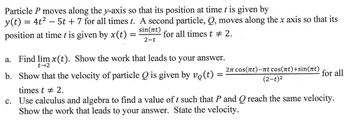Particle P moves along the y-axis so that its position at time t is given by (t) = 4t² − 5t + 7 for all times t. - position at time t is given by x(t) = A second particle, Q, moves along the x axis so that its sin(rt) for all times t # 2. 2-t . Find lim x(t). Show the work that leads to your answer. t-2 . Show that the velocity of particle Q is given by vo(t) 2n cos(rt)—nt cos(nt)+sin(zt) (2-t)² for all times t = 2. c. Use calculus and algebra to find a value of t such that P and Q reach the same velocity. Show the work that leads to your answer. State the velocity.
Particle P moves along the y-axis so that its position at time t is given by (t) = 4t² − 5t + 7 for all times t. - position at time t is given by x(t) = A second particle, Q, moves along the x axis so that its sin(rt) for all times t # 2. 2-t . Find lim x(t). Show the work that leads to your answer. t-2 . Show that the velocity of particle Q is given by vo(t) 2n cos(rt)—nt cos(nt)+sin(zt) (2-t)² for all times t = 2. c. Use calculus and algebra to find a value of t such that P and Q reach the same velocity. Show the work that leads to your answer. State the velocity.
Advanced Engineering Mathematics
10th Edition
ISBN:9780470458365
Author:Erwin Kreyszig
Publisher:Erwin Kreyszig
Chapter2: Second-order Linear Odes
Section: Chapter Questions
Problem 1RQ
Related questions
Question
See question which is attached.

Transcribed Image Text:Particle P moves along the y-axis so that its position at time t is given by
y(t) = 4t²5t + 7 for all times t. A second particle, Q, moves along the x axis so that its
sin(at)
position at time t is given by x(t)
for all times t # 2.
2-t
=
a. Find lim x(t). Show the work that leads to your answer.
t→2
b. Show that the velocity of particle Q is given by vo(t)
=
2π сos(лt)-лt cos(πt)+sin(πt)
(2-t)²
for all
times t # 2.
c. Use calculus and algebra to find a value of t such that P and Q reach the same velocity.
Show the work that leads to your answer. State the velocity.
Expert Solution
This question has been solved!
Explore an expertly crafted, step-by-step solution for a thorough understanding of key concepts.
This is a popular solution!
Trending now
This is a popular solution!
Step by step
Solved in 4 steps

Follow-up Questions
Read through expert solutions to related follow-up questions below.
Follow-up Question

Transcribed Image Text:Particle P moves along the y-axis so that its position at time t is given by
y(t) = 4t²5t + 7 for all times t. A second particle, Q, moves along the x axis so that its
sin(at)
position at time t is given by x(t)
for all times t # 2.
2-t
=
a. Find lim x(t). Show the work that leads to your answer.
t→2
b. Show that the velocity of particle Q is given by vo(t)
=
2π сos(лt)-лt cos(πt)+sin(πt)
(2-t)²
for all
times t # 2.
c. Use calculus and algebra to find a value of t such that P and Q reach the same velocity.
Show the work that leads to your answer. State the velocity.
Solution
Recommended textbooks for you

Advanced Engineering Mathematics
Advanced Math
ISBN:
9780470458365
Author:
Erwin Kreyszig
Publisher:
Wiley, John & Sons, Incorporated

Numerical Methods for Engineers
Advanced Math
ISBN:
9780073397924
Author:
Steven C. Chapra Dr., Raymond P. Canale
Publisher:
McGraw-Hill Education

Introductory Mathematics for Engineering Applicat…
Advanced Math
ISBN:
9781118141809
Author:
Nathan Klingbeil
Publisher:
WILEY

Advanced Engineering Mathematics
Advanced Math
ISBN:
9780470458365
Author:
Erwin Kreyszig
Publisher:
Wiley, John & Sons, Incorporated

Numerical Methods for Engineers
Advanced Math
ISBN:
9780073397924
Author:
Steven C. Chapra Dr., Raymond P. Canale
Publisher:
McGraw-Hill Education

Introductory Mathematics for Engineering Applicat…
Advanced Math
ISBN:
9781118141809
Author:
Nathan Klingbeil
Publisher:
WILEY

Mathematics For Machine Technology
Advanced Math
ISBN:
9781337798310
Author:
Peterson, John.
Publisher:
Cengage Learning,

